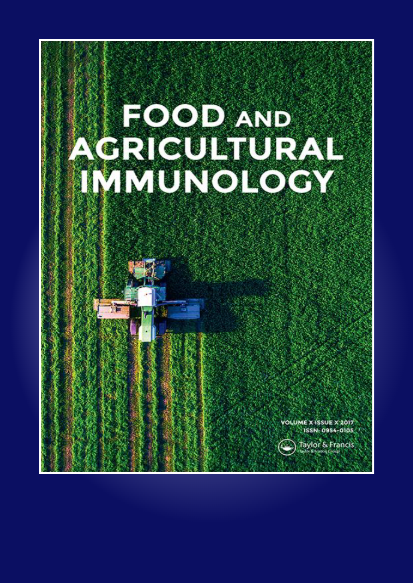柏树树皮提取物通过抑制α-MSH刺激的B16F10细胞中的CREB和MITF信号通路抑制黑色素生成
IF 2.1
3区 农林科学
Q3 CHEMISTRY, APPLIED
引用次数: 3
摘要
柏树(Chamaecyparis obtusa)树皮以其生物功能活性和高含量的多酚和黄酮类化合物而闻名。它以前表现出抗氧化、抗致病和抗炎的活性。本研究旨在研究柏树树皮提取物(CBE)的抗黑色素生成作用。我们评估了α-黑素细胞刺激激素(α-MSH)诱导的B16F10小鼠黑色素瘤细胞中的细胞酪氨酸酶活性和黑色素含量。我们使用蛋白质印迹分析分析了小眼相关转录因子(MITF)、酪氨酸酶相关蛋白(TRP1和TRP2)以及通过AKT和ERK的磷酸化激活的cAMP反应元件结合蛋白(CREB)。通过实时聚合酶链式反应检测酪氨酸酶、MITF、TRP1和TRP2的mRNA表达。CBE显著恢复了α-MSH刺激的黑色素瘤细胞中黑色素含量和酪氨酸酶活性。它通过抑制α-MSH诱导的B16F10细胞中的MITF、TRP1、TRP2、酪氨酸酶mRNA和蛋白质表达而表现出抗黑素生成作用。此外,CBE通过抑制AKT和细胞外信号调节激酶磷酸化显著抑制CREB活化。我们的数据有力地表明CBE对黑色素生成具有潜在的影响。图形摘要图形摘要:CBE抗黑色素生成作用的拟议机制。本文章由计算机程序翻译,如有差异,请以英文原文为准。
Cypress tree (Chamaecyparis obtusa) Bark extract inhibits melanogenesis through repressing CREB and MITF signalling pathways in α-MSH-stimulated B16F10 cells
ABSTRACT Cypress tree (Chamaecyparis obtusa) bark is well-known for its bio-functional activities and high content of polyphenol and flavonoids. It has previously exhibited antioxidant, anti-pathogenic, and anti-inflammatory activities. Our study aimed to investigate the anti-melanogenic effect of Cypress Tree Bark extract (CBE). We evaluated cellular tyrosinase activity and melanin content in alpha-melanocyte-stimulating hormone (α-MSH) induced B16F10 murine melanoma cells. We analyzed microphthalmia-associated transcription factor (MITF), tyrosinase-related protein (TRP1 and TRP2), and cAMP response element-binding protein (CREB) activation via phosphorylation of AKT and ERK using western blot analysis. Tyrosinase, MITF, TRP1, and TRP2 mRNA expression were examined via real-time polymerase chain reaction. CBE restored melanin content and tyrosinase activity remarkably in α-MSH stimulated melanoma cells. It exhibited an anti-melanogenic effect through suppressing MITF, TRP1, TRP2, tyrosinase mRNA and protein expression in α-MSH-induced B16F10 cells. Furthermore, CBE has significantly inhibited CREB activation by suppressing AKT and extracellular signal-regulated kinase phosphorylation. Our data strongly suggest that CBE has potential effects against melanogenesis. GRAPHICAL ABSTRACT Graphical Abstract: The proposed mechanism of CBE on anti-melanogenic effect.
求助全文
通过发布文献求助,成功后即可免费获取论文全文。
去求助
来源期刊

Food and Agricultural Immunology
农林科学-毒理学
CiteScore
5.30
自引率
6.70%
发文量
52
审稿时长
2 months
期刊介绍:
Food and Agricultural Immunology is an international open access journal publishing original immunological research with applications in food, agricultural, environmental and veterinary science. Submissions describing the use of immunological techniques and methods are particularly welcomed.
The journal aims to expand our understanding of the interactions at the interface of food and immune systems including studies on:
-Development of diagnostic systems – all types of ligand-based assays, e.g. antibody, aptamer
-Application of ligand-based assays for the detection or identification of molecules of interest in food science, agricultural research, veterinary investigations and clinical systems relating to food allergy or sensitivity to agricultural chemicals
-Effects of food on the immune system
-Studies on allergy and allergic reactions
-Investigations into food allergies
-Development of allergen-free food systems
-Development of novel assay formats
-Applications of assay systems to the monitoring of food items in relation to safety and labelling
-Food quality issues, e.g. speciation, adulteration and contamination
-Comparisons between different analytical techniques
The journal publishes research and review articles and is essential reading for food scientists, immunologists and all those concerned with the interaction between food and immune systems.
 求助内容:
求助内容: 应助结果提醒方式:
应助结果提醒方式:


